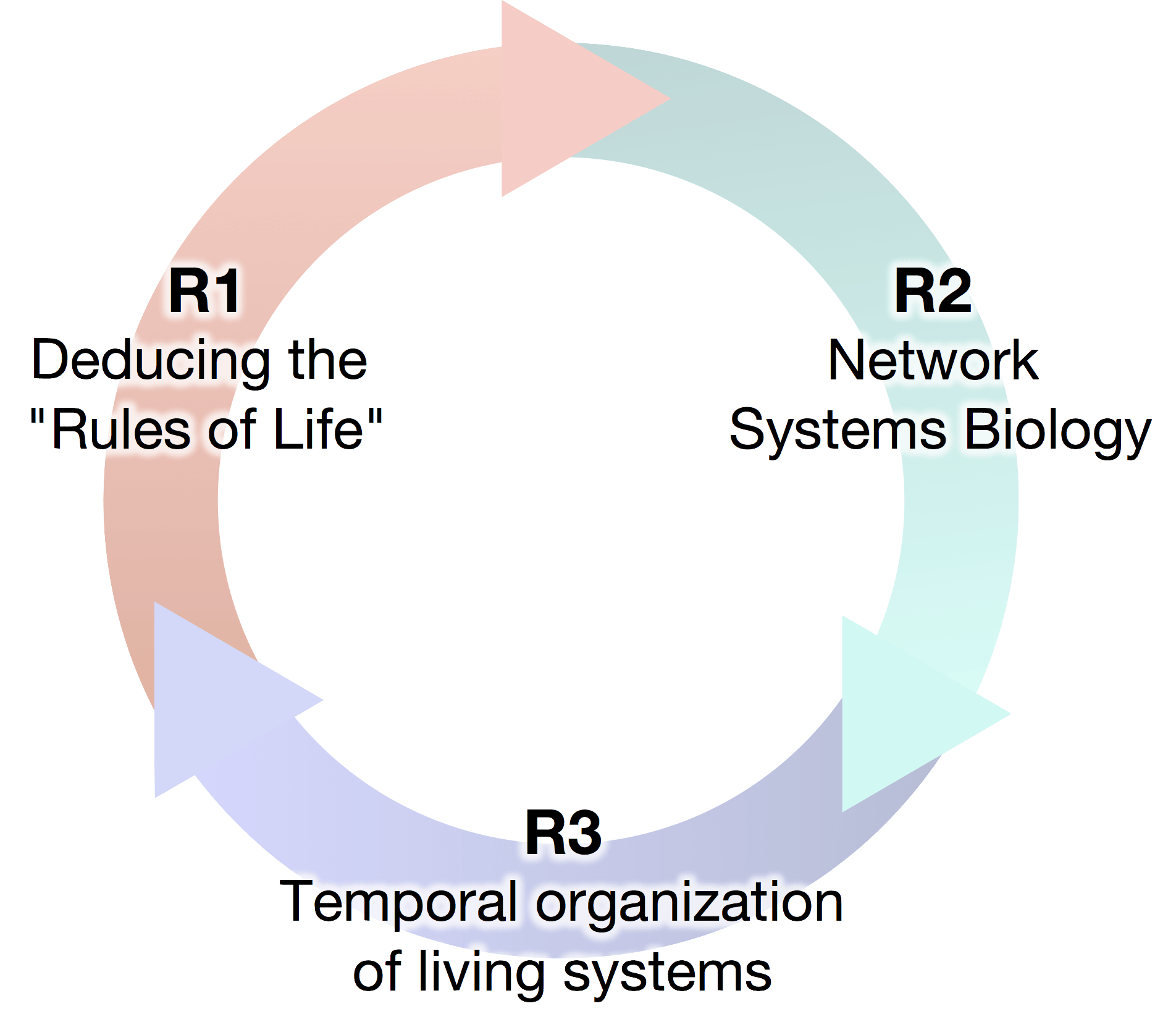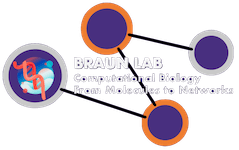
Living systems are governed by complex networks of molecular interactions involving hundreds of thousands of interacting elements. These systems are finely tuned to produce precise biological effects, robust enough to tolerate intrinsic and extrinsic variability, and flexible enough to adapt to environmental changes.
The central goal of our group’s research is to develop computational and mathematical method to analyze, predict, and ultimately modulate the behavior of these networks. Projects in the group are organized in three interconnected research themes (right).
Deducing the “Rules of Life”
What are the circuits that govern cellular function?
Understanding the relationship between genotype and phenotype requires accurate models of molecular interaction networks. Because experimentally testing all possible interactions is not feasible, there is considerable interest in methods that can computationally reconstruct regulatory networks from high-throughput omics data.

Network reconstruction methods need to address two fundamental challenges: First, the number of possible edges is very large compared to the number of samples, making accurate reconstructions from data alone an underdetermined problem. Second, biological regulation may take place at multiple levels (such as the interplay of non-coding micro-RNAs, genetic variants, pathways comprising protein-coding genes as shown at left).
We approach these problems by developing tools to reconstruct regulatory networks from the integrative analysis of large-scale multi-omics data, combining data at the genetic, transcriptomic, and epigenetic levels. We also incorporate putative interaction networks (eg, networks from pathway databases) as prior, enabling greater accuracy and biological fidelity than “de novo” reconstructions, while still enabling the final model to be data-driven.
Relevant publications in this area include:
- Wilk & Braun. regQTLs: Single nucleotide polymorphisms that modulate microRNA regulation of gene expression in tumors. PLoS Genet. 2018.
- Nguyen & Braun. Time-lagged Ordered Lasso for network inference. BMC Bioinformatics, 2018.
- Nguyen & Braun. Semi-supervised network inference using simulated gene expression dynamics. Bioinformatics, 2017.
Network Systems Biology
What can the structure of a network tell us about the system’s function?

The behavior of a given network is more than the simple sum of its parts: some networks are resilient, enabling the cell to adapt to changes in its environment, while others rigidly maintain precise functions. Using techniques derived from complex systems theory, graph theory (left), and machine learning, we develop techniques to analyze omics data in the context of interaction networks and predict how a network will respond to a perturbation.
Relevant publications in this area include:
- Shah & Braun. GeneSurrounder: network-based identification of disease genes in expression data. BMC Bioinformatics. 2019.
- Wilk & Braun. Integrative analysis reveals disrupted pathways regulated by microRNAs in cancer. Nucleic Acids Res. 2017.
- Shah & Braun. Network Methods for Pathway Analysis of Genomic Data. arXiv:1411.1993. 2014.
- Braun, Leibon, Pauls, & Rockmore. Partition decoupling for multi-gene analysis of gene expression profiling data. BMC Bioinformatics. 2011.
Temporal Organization of Living Systems
How are living processes coordinated in time?
Life is inherently dynamic, yet observing those dynamics experimentally is often challenging. A central goal of this research theme is to develop methods that can infer dynamical characteristics from static “snapshot” observations. A key application area of this work is the investigation of the circadian rhythm: an evolutionarily conserved intrinsic clock present in nearly every cell of your body.

The circadian rhythm is generated by a transcription-translation feedback loop, which is in turn coupled to drive the rhythmic expression of hundreds of genes (left). Despite its apparent simplicity, the core clock is not a simple chemical oscillator: it is temperature-compensated, enabling it to keep time in cold-blooded organisms even as chemical reaction rates change, while also being responsive to cues that enable it to be entrained to the organism’s environment. Studies have shows that the genes coupled to the clock are tissue- and condition-specific, enabling organisms to adapt to changes in their environment in a coordinated manner. Aberrations in circadian regulation are associated with neurodegeneration, heart disease, and diabetes.
Our lab develops methods to analyze and predict complex transcriptomic dynamics, and applies them in collaboration with the Allada lab and the Center for Circadian and Sleep Medicine to investigate fundamental circadian biology and its role in human health.
Relevant publications in this area include:
- Ness-Cohn, Iwanaszko, Kath, Allada, & Braun. TimeTrial: An Interactive Application for Optimizing the Design and Analysis of Transcriptomic Time-Series Data in Circadian Biology Research. J Biol Rhythms. 2020
- Braun &al. Universal method for robust detection of circadian state from gene expression. PNAS, 2018.
- Levine &al. NAD+ Controls Circadian Reprogramming through PER2 Nuclear Translocation to Counter Aging. Mol Cell. 2020.
Research area synergy
While the above Research Themes are a useful way to organize projects, none of them are isolated from the rest. For example, novel connections inferred in theme R1 can be incorporated in the topologies used to compute network–level statistics in theme R2. Those network statistics have implications for the dynamics of processes on the graph, linking R2 to R3. Finally, observations of dynamics are the best way to infer the causal relationships that define the “Rules of Life”, thus feeding R3 back to R1.
Collaborations
We collaborate extensively with experimentalists and clinicians, including:
- Allada Lab, Northwestern University
- NSF-Simons Center for Quantitative Biology, Northwestern University
- Misharin Lab, Northwestern University
- Zee Lab, Northwestern University

